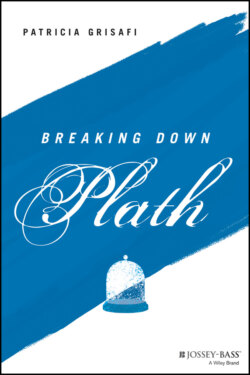Читать книгу Breaking Down Plath - Patricia Grisafi - Страница 16
THE CREATION OF PLATH THE MYTH
ОглавлениеHere's where Plath's life transforms into mythology, where a woman trying to survive the winter becomes a mad poet scribbling in the early morning poems of violence and otherworldliness. In this myth, Plath paces the small apartment twisting her hair. Her eyes are wild. She writes and writes and writes as if possessed. Her friend, writer and critic Al Alvarez, penned an iconic description that furthered this image:
I hardly recognised Sylvia when she opened the door. The bright young American house wife with her determined smile and crisp clothes had vanished along with the pancake make‐up, the school‐mistressy bun and fake cheerfulness. Her face was wax‐pale and drained: her hair hung loose down to her waist and left a faint, sharp animal scent on the air when she walked ahead of me up the stairs. She looked like a priestess emptied out by the rites of her cult. And perhaps that is what she had become. She had broken through to whatever it was that made her want to write, the poems were coming every day, sometimes as many as three a day, unbidden, unstoppable, and she was off in a closed, private world where no one was going to follow her. (Alvarez, 1970)
In reality, we can never know what went through Sylvia Plath's mind during this time. Through letters she wrote and interviews with friends and neighbors during her last few weeks, we know Plath reached out to friends, her primary care physician, Dr. Horder, and her former therapist, Dr. Beuscher. Plath was severely depressed and without adequate support: “I am suddenly in agony, desperate, thinking Yes let him [Hughes] take over the house, the children, let me just die & be done with it. How can I get out of this ghastly defeatist cycle & grow up. I am only too aware that love and a husband are impossibles to me at this time, I am incapable of being myself and loving myself,” she wrote to Beuscher on February 4.
On Monday, February 11, 1963, Plath died by suicide. She sealed herself off in the kitchen, away from her children, and turned the gas on. She left the manuscript for Ariel and Other Poems neatly on her desk. Later, Dr. Horder explained that he had found a bed for Plath at a mental hospital and she was set to be admitted on February 11 (Clark, 2020, p. 891). Biographer Heather Clark thinks that, in addition to suffering from depression and using medications carelessly, “the prospect of a potentially horrific stay in an unknown mental hospital was one that filled Plath with fear…she was on the verge of surrendering herself to unknown psychiatrists—likely all men—in a notorious asylum” (Clark, 2020, p. 887).
Plath did not leave a suicide letter; a note was found by the baby stroller that simply read: “PLEASE CALL DR. HORDER AT PRI 3804.” Plath's body was discovered that morning by the visiting nurse she had enlisted to help care for the children.
Ariel and Other Poems was later edited by Ted Hughes and published as Ariel in 1965. In a controversial move, Hughes reorganized the structure of the manuscript and removed poems that he considered cast him in a bad light. Hughes chose to end Ariel on “Words,” a poem that references fate in its last lines: “fixed stars govern a life.” What Hughes seemed to be saying with his reorganization was that Plath's suicide was unpreventable and destined to happen—thus distancing himself from his wife's desperate act.
In 2004, Frieda Hughes released her mother's original poetic manuscript, which showed the public that her mother had a very different vision of the collection that made her famous. In particular, Plath concluded her version with the cycle of bee poems, with the last line of the last poem giving a sense of optimism: “The bees are flying. They taste the spring.”
